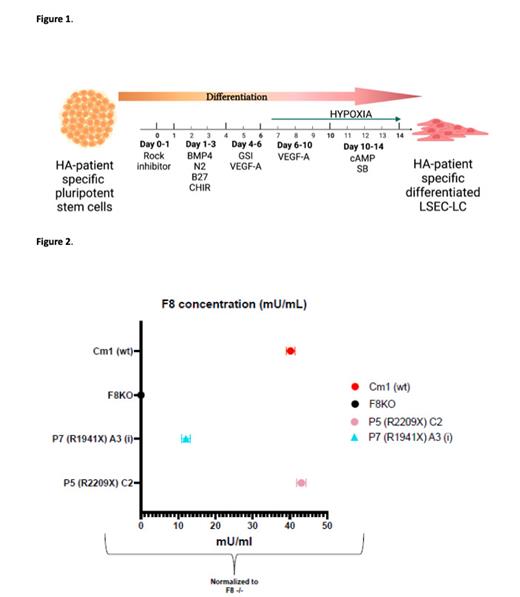MS
Background:
Liver sinusoidal endothelial cells (LSEC) are unique endothelial cells and secretion and expression of FVIII is one of their key functions. Pluripotent stem cells from healthy donors can be a source of generating organ-specific endothelial cells in vitro. However, maintaining the specification of LSEC markers remains a challenge. Currently, EBs with a combination of AMP activation,TGF-ß inhibition,and hypoxia are a state of the art to derive LSEC-like EC from IPS. A 2D monolayer-based approach shows potential in culturing these ECs and in maintaining their correct specification (Fig. 1).IPSc-differentiated LSEC were analyzed for the presence of LSEC-specific markers FCGR2b, Stab2 & F8 by rtPCR. Our data shows that day 10 angioblasts mark an increase of venous markers COUP-TF and NT5E under low VEGF-A conditions. Upon LSEC induction LSEC markers are upregulated compared to HUVEC:FCGR2b(2x), Stab2(37x), and F8(7x) (not shown). Flow cytometry(FC) analyses depict a KDR +CD56 + phenotype for mesoderm on day 4 ,a venous CD31 +CD34 +CD184 lowCD73 high phenotype for day 6 angioblast and a CD34 +FCGR2b +Stab2 +LYVE1 + LSEC-LC population successfully maintained until Day 15 (not shown).ELISA measurements (Fig. 2) using a FVIII-A3 specific biotinylated nanobody detects FVIII in LSEC-LC from healthy donor, HA-patient with I22I and in both high risk inhibitor nonsense mutations R1960X and R2228X. These preliminary results warranted the confirmation of detection as well as the need to decipher the differences in the FVIII protein among the healthy donor and patients with HA.
Aim:
Detection of endogenous FVIII protein in healthy donors and patients using immunofluorescence(IF).
Detection of FVIII protein using mass spectrometry (MS)
Methods: IF was conducted using a monoclonal antibody (GMA8021) and the difference in protein levels was measured using the mean fluorescence intensity (MFI) values. An immunoprecipitation-based method to detect the natural FVIII protein using MS was developed. Initially, an ultracentrifugation step eliminated the background proteome which allowed for the antibody (SAF8C) based capture of FVIII using a column-based elution technique. The eluted sample was trypsinized and detected via nano-LC coupled to LC/MS Orbitrap.
Results:
The MFI of the healthy donor is 2.8x, 2.5x, 2.31x, 2x and 1.3x higher than F8KO, HUVEC, HA-patient samples R2228X, R1960X and I22I,respectively.
Healthy donor shows the presence of 5 FVIII peptides. Patient sample with mutation I22I shows the presence of 1 FVIII peptide. Patient sample with nonsense mutation R1960X showed 2 FVIII peptides while patient sample with R2228X was unable to show any FVIII peptides.
Conclusion: While FVIII detection in multiple overexpressed models of HA have been established, our current LSEC model is a milestone in detecting the natural, native state of the FVIII protein. This LSEC-LC model provides a 7-fold higher F8 expression compared to HUVEC in vitro system. FC analysis shows the right phenotype for modeling IPSc into LSEC. The additional presence of LSEC-specific receptors and confirmation of FVIII in the healthy donor and patients with nonsense mutations enables a more native and precise disease modeling for HA research and therapy.
Disclosures
Oldenburg:Octapharma: Honoraria, Research Funding; SOBI: Honoraria, Research Funding; Pfizer: Honoraria, Research Funding; Chugai: Honoraria; CSL Behring: Honoraria, Research Funding; Biotest: Honoraria, Research Funding; Biogen Idec: Honoraria; Freeline: Honoraria; Takeda: Honoraria, Research Funding; Novo Nordisk: Honoraria; Roche: Honoraria; Grifols: Honoraria; BioMarin: Honoraria; Sparks: Honoraria; Bayer: Honoraria, Research Funding.


This feature is available to Subscribers Only
Sign In or Create an Account Close Modal